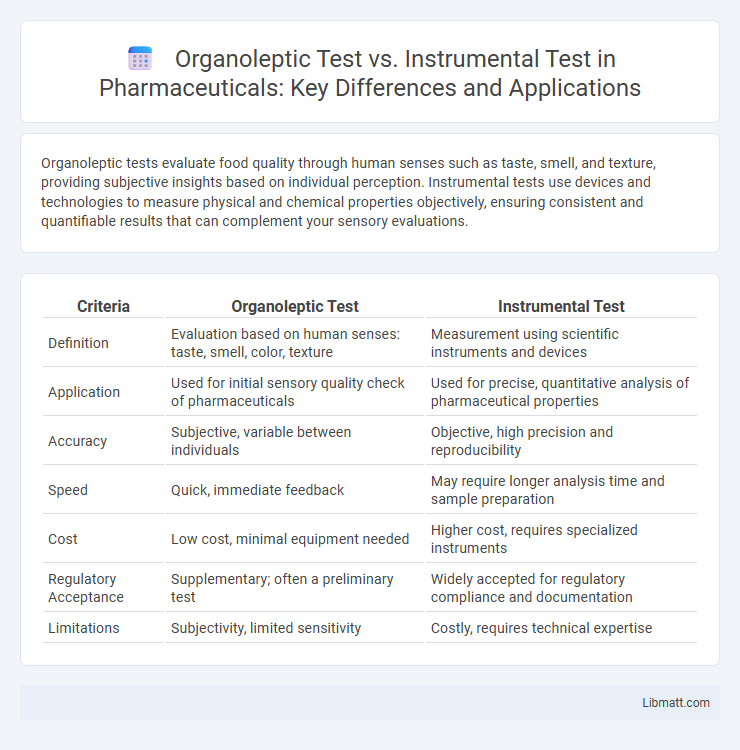Organoleptic tests evaluate food quality through human senses such as taste, smell, and texture, providing subjective insights based on individual perception. Instrumental tests use devices and technologies to measure physical and chemical properties objectively, ensuring consistent and quantifiable results that can complement your sensory evaluations.
Table of Comparison
| Criteria | Organoleptic Test | Instrumental Test |
|---|---|---|
| Definition | Evaluation based on human senses: taste, smell, color, texture | Measurement using scientific instruments and devices |
| Application | Used for initial sensory quality check of pharmaceuticals | Used for precise, quantitative analysis of pharmaceutical properties |
| Accuracy | Subjective, variable between individuals | Objective, high precision and reproducibility |
| Speed | Quick, immediate feedback | May require longer analysis time and sample preparation |
| Cost | Low cost, minimal equipment needed | Higher cost, requires specialized instruments |
| Regulatory Acceptance | Supplementary; often a preliminary test | Widely accepted for regulatory compliance and documentation |
| Limitations | Subjectivity, limited sensitivity | Costly, requires technical expertise |
Introduction to Organoleptic and Instrumental Tests
Organoleptic tests evaluate food quality through human senses such as taste, smell, sight, touch, and sound, providing direct sensory feedback on flavor and texture. Instrumental tests use advanced devices and technology to measure physical and chemical properties, ensuring objective and precise data on attributes like color, texture, and aroma. Both testing methods are essential in food quality control, where organoleptic tests offer subjective sensory insights and instrumental tests deliver quantifiable and reproducible results.
Definition and Overview of Organoleptic Tests
Organoleptic tests involve the evaluation of food, beverages, or products using human senses such as taste, smell, sight, touch, and hearing to assess quality and acceptability. These sensory assessments are crucial for detecting attributes like flavor, aroma, texture, and appearance that instrumental tests might not fully capture. Your product's sensory profile is vital in organoleptic testing, ensuring consumer satisfaction and aligning with market expectations.
Definition and Overview of Instrumental Tests
Instrumental tests refer to analytical methods that use devices and sensors to measure physical and chemical properties of products with high precision and repeatability. These tests quantify attributes such as texture, color, aroma, and taste objectively, eliminating human bias common in organoleptic evaluations. Your product quality assessment benefits from instrumental tests by providing consistent data crucial for standardization and quality control.
Key Differences Between Organoleptic and Instrumental Testing
Organoleptic testing relies on human senses such as taste, smell, sight, and touch to evaluate product quality, making it subjective and influenced by individual perception. Instrumental testing uses precise devices and technology to measure physical and chemical properties, ensuring objective, repeatable, and quantifiable results. Your choice between these methods depends on the need for sensory feedback versus scientific accuracy in product assessment.
Advantages of Organoleptic Testing
Organoleptic testing offers the advantage of directly assessing sensory attributes such as taste, smell, texture, and appearance, providing a comprehensive evaluation that instruments may overlook. This method captures subtle nuances and consumer preferences, making it invaluable for product development and quality control in food and beverage industries. Your ability to detect complex sensory changes ensures a more authentic and immediate understanding of product quality.
Advantages of Instrumental Testing
Instrumental testing offers precise, objective, and reproducible measurements of food quality attributes such as texture, color, and aroma, minimizing human bias present in organoleptic tests. This method can handle large sample volumes efficiently, ensuring consistency and reliability in quality control processes across production batches. Advanced instruments provide quantifiable data that facilitate regulatory compliance and support product development through detailed analysis.
Limitations of Organoleptic Methods
Organoleptic tests rely on human senses, leading to subjective variations and limited reproducibility due to differences in individual perception and sensitivity. These methods are constrained by fatigue, bias, and the inability to quantify certain sensory attributes precisely, reducing reliability for detailed analysis. Instrumental tests provide objective, consistent data, overcoming the inherent limitations of organoleptic evaluations in product quality and safety assessment.
Limitations of Instrumental Methods
Instrumental methods for food quality analysis provide precise and objective measurements but often fail to capture complex sensory attributes such as taste, aroma, and mouthfeel, which are critical for consumer acceptance. These methods can be limited by their inability to replicate human perception and may overlook subtle nuances that organoleptic tests detect through trained sensory panels. Furthermore, instrumental analysis may require expensive equipment and skilled operators, making it less accessible for routine quality control compared to traditional sensory evaluation.
Applications in Food and Beverage Industry
Organoleptic tests assess food and beverage quality through human sensory evaluation, crucial for flavor, aroma, texture, and appearance analysis in product development and quality control. Instrumental tests use devices like spectrophotometers and chromatographs for precise measurement of chemical composition, color, and texture, enabling objective and consistent data for safety and authenticity verification. Combining both methods enhances product optimization, ensuring consumer satisfaction and regulatory compliance in the food and beverage industry.
Choosing the Right Test: Organoleptic vs Instrumental
Choosing between organoleptic and instrumental tests depends on the specific quality attributes you need to evaluate. Organoleptic tests rely on human senses to assess sensory characteristics like taste, aroma, and texture, making them ideal for subjective quality control where consumer perception matters most. Instrumental tests provide objective, precise, and reproducible data on chemical and physical properties, suitable for detailed analysis and regulatory compliance.
Organoleptic test vs instrumental test Infographic

 libmatt.com
libmatt.com